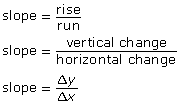Lesson 4: Slope
Module 4: General Relations
Lesson 4 Summary
In this lesson you examined the following questions:
-
How can slope be used to describe the properties of objects?
-
Why is it possible to use any two points to determine the slope of a line?
The slope of a line is the measure of the line’s steepness. In this lesson you learned that you can interpret slope in three equivalent ways:

Slope can have positive or negative values, and slopes can also be equal to zero or they can be undefined. The slope of a line depends on its orientation. Specifically, this includes the following:
-
Lines rising to the right have a positive slope.
-
Lines falling to the right have a negative slope.
-
Lines parallel to the x-axis have a slope of 0.
-
Lines parallel to the y-axis have a slope that is undefined.
Throughout this lesson you saw how slope is applied in the construction of everyday objects. Slope is a major consideration in the building of stairs (both ancient and modern), ramps, and roofs. Slope is also a major factor for engineers who are responsible for designing Olympic event courses from ski jumping and bobsled racing in the winter to mountain biking and BMX racing in the summer. You may have discovered during this lesson that there are other words to describe slope such as grade, pitch, and incline. These expressions all describe the steepness of an object.
You also learned that you can calculate the slope of a line by determining the rise and run between any two points on a line. The reason for this is that the slope of a line is constant. You verified this by comparing the slope of a staircase, one step in the staircase, and consecutive steps in a staircase. The formula for the slope of a line given two points on the line with coordinates (x1, y1) and (x2, y2) is
![]() where m is the slope
where m is the slope
In Lesson 5 you will look at how you can use the slope of a line to find additional points on the line or to draw the line itself on the Cartesian plane. You will also investigate slope as a rate of change and explore how the slope of a line applies to real-world problems.